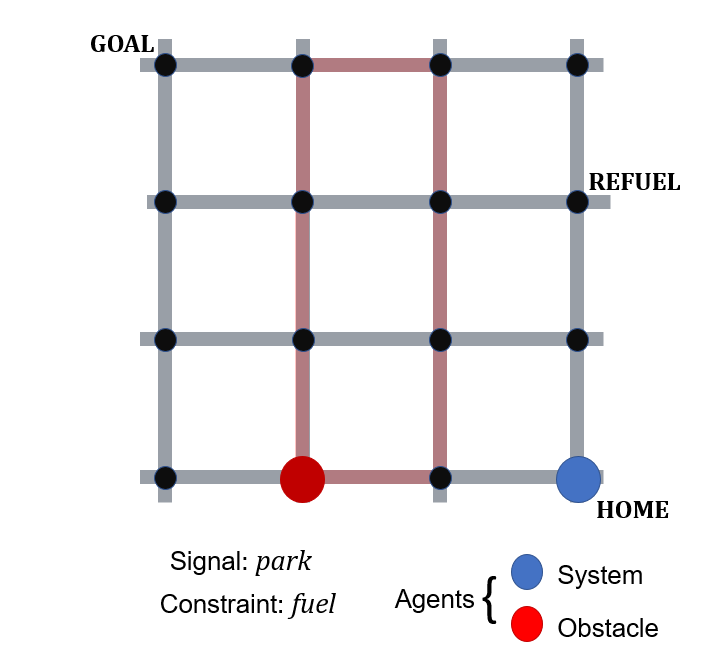SURF 2020: Test and Evaluation for Autonomy: Difference between revisions
No edit summary |
No edit summary |
||
| Line 3: | Line 3: | ||
The architecture of autonomous systems can be represented in a hierarchy of levels (see figure below) with a discrete decision-making layer at the top and low-level controllers at the bottom. In this project, we will be focusing on testing at the top layer, that is, testing for discrete event systems. The requirements of the system under consideration can be represented as specifications in a formal language. Most commonly in theory, specifications are written in temporal logic languages such as Linear Temporal Logic (LTL), Signal Temporal Logic (STL), Computational Tree Logic (CTL), etc (See references 2 and 3 for an overview on writing specifications in temporal logic). In addition to the system and its specifications, we have an environment for which corresponding specifications can be written. The environment constitutes of other agents modeled in the problem statement that do not constitute the system. See Figure 2 below for an example scenario of the system / environment. | The architecture of autonomous systems can be represented in a hierarchy of levels (see figure below) with a discrete decision-making layer at the top and low-level controllers at the bottom. In this project, we will be focusing on testing at the top layer, that is, testing for discrete event systems. The requirements of the system under consideration can be represented as specifications in a formal language. Most commonly in theory, specifications are written in temporal logic languages such as Linear Temporal Logic (LTL), Signal Temporal Logic (STL), Computational Tree Logic (CTL), etc (See references 2 and 3 for an overview on writing specifications in temporal logic). In addition to the system and its specifications, we have an environment for which corresponding specifications can be written. The environment constitutes of other agents modeled in the problem statement that do not constitute the system. See Figure 2 below for an example scenario of the system / environment. | ||
[[Image:architecture_auton_sys.png|frame | [[Image:architecture_auton_sys.png|400px|frame|left|Figure 1: Architecture of autonomous systems]] | ||
[[Image:gridworld_sys_env.png|frame | [[Image:gridworld_sys_env.png|400px|frame|right|Figure 2: Blue agent constitutes the system. It's objective is to always eventually go to GOAL when the park signal is ON, and always eventually go HOME when the ''park'' signal is OFF. With every step, its FUEL decreases by 1 unit. The blue agent must accomplish these objectives without running out of FUEL and without hitting the obstacle (red) patrolling agent. The red patrolling car and the ''park'' signal constitute the environment. The ''park'' signal can only take ON/OFF values and the red agent can only move along the red-transition lines on the grid.]] | ||
A test is a sequence of environmental inputs to the system with the objective of finding faults in the system. From test data, we can evaluate whether the system has passed the test. One of the difficulties with testing autonomous systems is that under the same environmental conditions, the system might choose to take different actions. | A test is a sequence of environmental inputs to the system with the objective of finding faults in the system. From test data, we can evaluate whether the system has passed the test. One of the difficulties with testing autonomous systems is that under the same environmental conditions, the system might choose to take different actions. | ||
Revision as of 23:33, 10 December 2019
Autonomous systems are an emerging technology with potential for growth and impact in safety-critical applications such as self-driving cars, space missions, distributed power grid. In these applications, a rigorous, proof-based framework for design, test and evaluation of autonomy is necessary.
The architecture of autonomous systems can be represented in a hierarchy of levels (see figure below) with a discrete decision-making layer at the top and low-level controllers at the bottom. In this project, we will be focusing on testing at the top layer, that is, testing for discrete event systems. The requirements of the system under consideration can be represented as specifications in a formal language. Most commonly in theory, specifications are written in temporal logic languages such as Linear Temporal Logic (LTL), Signal Temporal Logic (STL), Computational Tree Logic (CTL), etc (See references 2 and 3 for an overview on writing specifications in temporal logic). In addition to the system and its specifications, we have an environment for which corresponding specifications can be written. The environment constitutes of other agents modeled in the problem statement that do not constitute the system. See Figure 2 below for an example scenario of the system / environment.

A test is a sequence of environmental inputs to the system with the objective of finding faults in the system. From test data, we can evaluate whether the system has passed the test. One of the difficulties with testing autonomous systems is that under the same environmental conditions, the system might choose to take different actions. Here are a few different possibilities for a SURF project:
1)How do we leverage test data to design the next set of tests? Specifically, for each trace of system actions, can we generate a set of environment traces to form the next round of tests?
2)Use test data to identify if the fault was caused because of information not captured in the discrete system model.
It would be useful for the SURF student to know MATLAB and Python.
References:
1. Bartocci, Ezio, et al. "Specification-based monitoring of cyber-physical systems: a survey on theory, tools and applications." Lectures on Runtime Verification. Springer, Cham, 2018. 135-175. Link
2. RM Murray, U. Topcu, N. Wongpiromsarn. HYCON-EECI, 2013 Link
3. On Signal Temporal Logic. A. Donze, 2014 Link
4. Wongpiromsarn, Tichakorn, et al. "TuLiP: a software toolbox for receding horizon temporal logic planning." Proceedings of the 14th international conference on Hybrid systems: computation and control. ACM, 2011. Link
